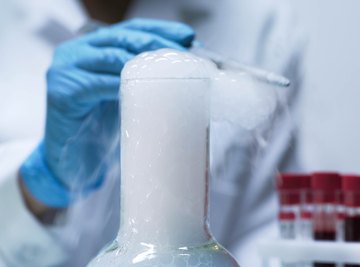
Nicotinamide adenine dinucleotide, or NAD, is in all living cells, where it functions as a coenzyme. It exists in either an oxidized form, NAD+, which can accept a hydrogen atom (i.e., a proton), or a reduced form, NADH, which can donate a hydrogen atom. Note that "donate a proton" and "accept a pair of electrons" translates to the same thing in biochemistry.
Nicotinamide adenine dinucleotide phosphate, or NADP+, is a similar molecule with a similar function, differing from NAD+ in that it contains an additional phosphate group. The oxidized form is NADP+, while the reduced form is NADPH.
NADH Basics
NADH contains two phosphate groups linked by an oxygen molecule. Each phosphate group joins a five-carbon ribose sugar. One of these in turn links to an adenine molecule, while the other links to a nicotinamide molecule. The transition from NAD+ to NADH occurs specifically at the nitrogen molecule in the ring structure of nicotinamide.
NADH takes part in metabolism by accepting and donating electrons, with the energy driving this flowing from the cellular citric acid cycle or tricarboxylic acid (TCA) cycle. This electron transport occurs in cellular mitochrondrial membranes.
NADPH Basics
NADPH also contains two phosphate groups linked by an oxygen molecule. As in NADH, each phosphate group joins a five-carbon ribose sugar. One of these in turn links to an adenine molecule, while the other links to a nicotinamide molecule. Unlike the case with NADH, however, the same five-carbon ribose sugar that joins adenine carries a second phosphate group, for a total of three phosphate groups in total. The transition from NADP+ to NADPH again occurs at the nitrogen molecule in the ring structure of nicotinamide.
NADPH's main job is participating in the synthesis of carbohydrates in photosynthetic organisms, such as plants. It helps power the Calvin cycle. It also has antioxidant functions.
Proposed Functions of Both NADH and NADPH
In addition to the direct contributions to cellular metabolism described above, both NADH and NADPH may take part in other important physiological processes, including mitochondrial functions, calcium regulation, antioxidation and its counterpart (the generation of oxidative stress), gene expression, immune functions, the aging process and cell death. As a result, some biochemistry researchers have proposed that further investigation of the less well-established properties of NADH and NADPH may offer more insight about the fundamental properties of life and reveal strategies for not only treating diseases but even slowing the aging process.
References
About the Author
Kevin Beck holds a bachelor's degree in physics with minors in math and chemistry from the University of Vermont. Formerly with ScienceBlogs.com and the editor of "Run Strong," he has written for Runner's World, Men's Fitness, Competitor, and a variety of other publications. More about Kevin and links to his professional work can be found at www.kemibe.com.
